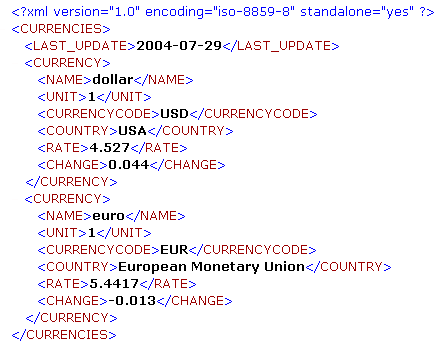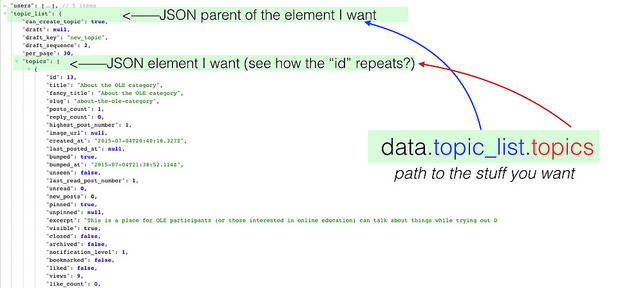Difference between JSON and XML
Both JSON and XML are text-based human readable formats with support for creating, reading, and decoding in real world applications. Both are hierarchical and language-independent text notation for data-interchange.
Despite the common traits, they differ in many aspects like data types, verbosity, tool stack, etc. While XML is a text-based markup language which specializes in business to business transactions on the World Wide Web, JSON is a lightweight open-standard format for data-interchange which is extended from JavaScript.
XML stands for “Extensive Markup Language” and is written in a similar way as followed by HTML, whereas JSON stand for “JavaScript Object Notation” which is a subset of the JavaScript syntax and is completely language-independent.

What is XML?
XML (short for Extensive Markup Language), is a text-based data format derived from SGML (ISO 8879) and is written in a similar way followed by HTML. The XML format has been around for years and was primarily developed to overcome the challenges of large-scale electronic publishing.
What it simply does is outsource data. It stores data in plain text format rather than integrating them into HTML document which makes it ideal for representing hierarchical data such as documents, transactions, invoices, books, and more.
It’s an independent data-interchange format that encodes documents in a format that is both machine-readable and human-readable. It’s a flexible way to create information formats and share structured data on the World Wide Web.
It’s actually a subset of the SGML (Standard Generalized Markup Language), similar to HTML which contains markup symbols to describe the contents of a page allowing users to define their own customized markup languages.
The main advantage of XML is that it is platform independent which means users can take data from other programs like SQL and convert them into XML then share the data with other platforms. Simple speaking, it’s a document-oriented technology that provides the capability to store and display data in both machine-readable and human-readable format.
It’s more like a meta-language with no inherent semantics which makes it an ideal format for creating ad-hoc data and documenting information formats.

What is JSON?
JSON (short for JavaScript Object Notation) is yet another text-based data-interchange format which uses text and number data types to represent objects. It’s an open-standard format based on the subset of JavaScript programming language and is completely language-independent.
It’s a way to transmit data objects consisting of array data types and attribute-value pairs between a server and the web browser. It uses a human-readable format to represent simple data structures in web application-based code.
Because of its flexibility, JSON is better suited for data-interchange between web applications and web services. As a markup language, XML only adds extra information to a plain text, whereas JSON, as the name suggests, is a way of representing data objects.
It is also used in desktop as well as server-side programming environments. Unlike XML, JSON takes a simple approach to represent structure data without complex mathematical notation and algorithms, plus it’s easy to learn which makes it an ideal way to create more interactive pages.
As they say, problem of one is the advantage of other. XML syntax is semantics-free, but it’s verbose which means its complexity makes it hard to be used for every application.
XML was designed to improve readability, but not to be efficient. JSON syntax is much more compact with its established semantics which makes it a preferred data format over XML.
Difference between JSON and XML
Definition of JSON and XML
XML is a simplified version of the SGML used to store and represent structured data in a format that is both machine-readable and human-readable. It’s designed to improve readability as it’s a markup language which adds extra information to plain text. JSON, on the other hand, is a lightweight data-interchange format used to represent hierarchical data and is based on JavaScript object syntax.
Meaning of JSON and XML
XML is short for “Extensive Markup Language” and is a document-oriented technology used to encode data in a human-readable format. It’s a flexible file format suitable for web use. JSON stands for “JavaScript Object Notation” and as the name suggests, it’s based on the JavaScript programming language.
Purpose of JSON and XML
XML was developed by the World Wide Web Consortium as a well-documented open standard format containing a set of rules on how to encode documents in both human-readable and machine-readable format. JSON was developed by Douglas Crockford as a simple, lightweight file format for data interchange.
Syntax of JSON and XML
JSON has no start and end tags and the syntax is lighter than XML as it’s data-oriented with less redundancy which makes it an ideal alternative for interchanging data over XML. XML, on the other hand, takes more characters to represent same data. It’s not as lightweight as JSON.
Data Type in JSON and XML
JSON supports text and number data type including integer and strings. Structured data is represented using arrays and objects. XML has no direct support for array type but it supports many data types such as number, text, images, graphs, charts, etc.
JSON vs. XML: Comparison Chart

Summary of JSON vs. XML
While both JSON and XML are two most popular file formats for interchanging data, they serve different purposes. Both are text-based human-readable formats with well-documented open standards on the World Wide Web. One of the fundamental differences between the two is that JSON is data-oriented whereas XML is document-oriented. Both are simple and easy to learn and are language-independent, however, each one of them is better suited for different tasks. In simple terms, XML is just a markup language which is used to add extra info to plain-text, whereas JSON is an efficient way to represent structured data in a human-readable format.
- Difference Between Caucus and Primary - June 18, 2024
- Difference Between PPO and POS - May 30, 2024
- Difference Between RFID and NFC - May 28, 2024
Search DifferenceBetween.net :
Leave a Response
References :
[0]Image Credit: https://commons.wikimedia.org/wiki/File:XMLSample.png#/media/File:XMLSample.png
[1]Image Credit: https://www.flickr.com/photos/bionicteaching/19898528539
[2]Friesen, Jeff. Java XML and JSON. New York City: Apress, 2016. Print
[3]Marrs, Tom. JSON at Work: Practical Data Integration for the Web. Sebastopol: O’Reilly Media, 2017. Print
[4]Bassett, Lindsay. Introduction to JavaScript Object Notation. Sebastopol: O’Reilly Media, 2015. Print
